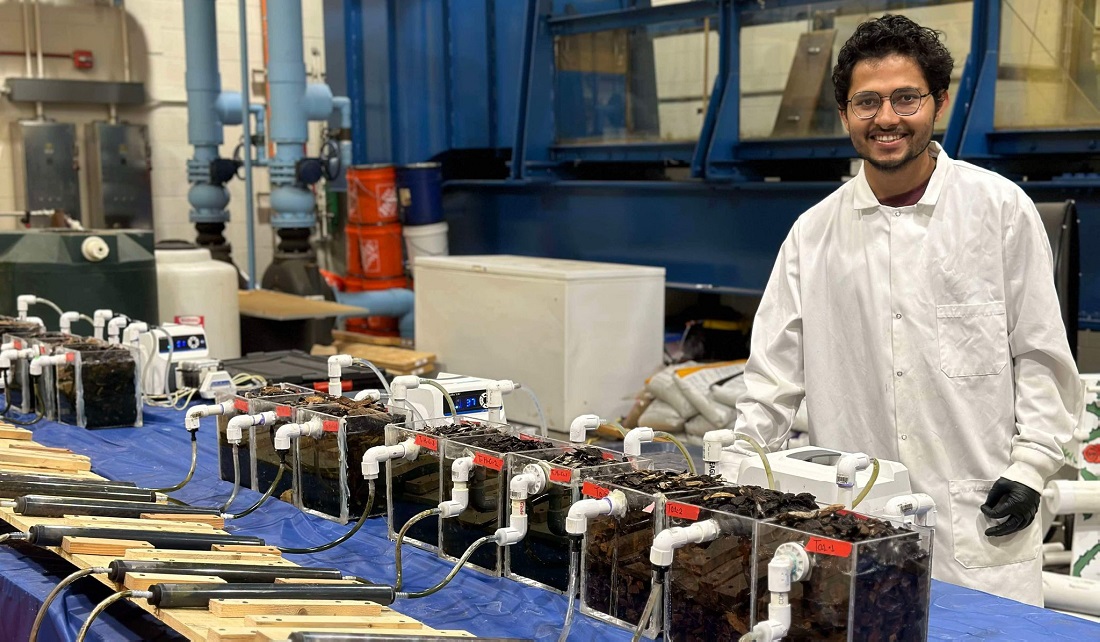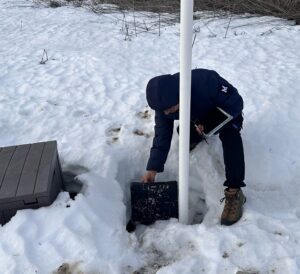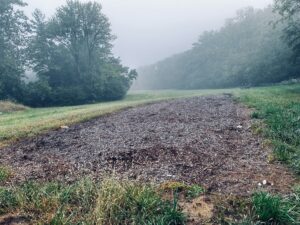
Meet Our Grad Student Scholars is a series from Illinois-Indiana Sea Grant (IISG) celebrating the students and research funded by our scholars program. To learn more about our faculty and graduate student funding opportunities, visit Fellowships & Scholarships.
Haribansha Timalsina is a third-year Ph.D. student in Agricultural and Biological Engineering at the University of Illinois at Urbana-Champaign, under the guidance of Rabin Bhattarai in the Water Quality Lab. His research focuses on optimizing nature-based practices to mitigate non-point source nutrient pollution to improve water quality in the Great Lakes region and Mississippi River Basin. The funding from IISG supports broadening the scope of his research work on designing, experimenting, and scaling up the combined strategy for mitigating dual nutrients (nitrogen and phosphorus) from agricultural watersheds.
Nutrients like nitrogen and phosphorus are essential for agricultural productivity–they support plant growth and food production to meet the demands of a growing population. However, excessive nutrient runoff from agricultural landscapes has become a major environmental concern, contaminating water bodies and fueling harmful algal blooms. These blooms deplete oxygen levels, disrupt aquatic ecosystems, and threaten drinking water supplies, fisheries, and recreation.

The Water Quality Laboratory monitors the woodchip bioreactor control structures in Galva, Illinois.
The Great Lakes and the Mississippi River Basin are particularly vulnerable to nutrient pollution due to intensive agricultural activity. Despite decades of regulations and conservation efforts, non-point source (NPS) nutrient pollution remains a persistent challenge, exacerbated by increasing food demands and climate change. Addressing this issue requires continuous innovation in conservation strategies that balance agricultural productivity with environmental protection.
At the Water Quality Laboratory at the University of Illinois at Urbana-Champaign, we take a systematic, multi-scale approach to tackling NPS nutrient pollution. Our research integrates controlled laboratory experiments, field-scale monitoring, and hydrological modeling to develop effective and scalable conservation practices.
One of the key conservation strategies under investigation is the use of woodchip bioreactors—a nature-based solution designed to remove nitrate from agricultural drainage. These bioreactors provide a carbon source that supports microbial denitrification, converting nitrate into harmless nitrogen gas. While effective for nitrate removal, woodchips do not efficiently remove phosphorus, which often coexists in drainage water and contributes to downstream water quality issues.
To better understand the efficiency of the system, our research group has been monitoring full-scale woodchip bioreactors across six locations in Illinois at high precision, treating drainage from 17 to over 50 acres, including one of the state’s largest bioreactors. By analyzing hydrological dynamics such as tile flow, temperature variations, and system design, we aim to better understand the systems, improve nitrate removal efficiency, and assess potential secondary environmental impacts, such as phosphorus leaching.

One of the largest woodchip bioreactors in Illinois is installed near an agricultural field in Springfield.
Building on these field-scale insights, I designed and evaluated an integrated system that combines woodchip bioreactors with waste-derived adsorbents, including modified bottom ash pellets. This system enhances phosphorus removal while maintaining nitrate removal efficiency. Through extensive laboratory investigations, I assessed the adsorption capacities of these materials and optimized system configurations for dual nutrient removal.
Moving forward, I aim to incorporate laboratory and field study results into watershed-scale hydrological models. By simulating nutrient transport and system performance under different environmental conditions, these models will help guide informed decision-making for regional conservation planning. This approach ensures that naturally based and waste-derived conservation practices can be effectively scaled up for large-scale nutrient loss mitigation, providing long-term environmental and economic benefits.
By advancing science-driven solutions and integrating green infrastructure, we can improve water quality, protect critical ecosystems, and promote agricultural sustainability, ensuring resilient food production and clean water for future generations.

